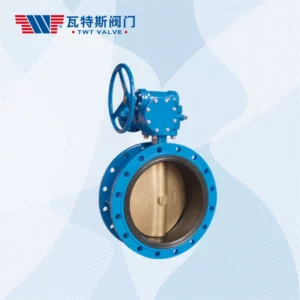Double flange butterfly valves are a type of industrial valve that is commonly used in pipelines for regulating flow. They are designed with two flanges that bolt directly to the pipeline, and a disc that rotates 90 degrees to control the flow of fluid. There are several types of double flange butterfly valves, each with its own unique features and advantages.
Here are some of the most common types:
Concentric Butterfly Valve: This type of valve has a disc that is centered in the valve body, and is designed to provide a tight seal against the seat. Concentric butterfly valves are commonly used in low-pressure applications.
Double Offset Butterfly Valve: This type of valve has a disc that is offset from the center of the valve body, which reduces wear on the seat and improves sealing performance. Double offset butterfly valves are commonly used in high-pressure applications.
Triple Offset Butterfly Valve: This type of valve has a disc that is offset from the center of the valve body, and also has a third offset that allows the disc to rotate without rubbing against the seat. Triple offset butterfly valves are commonly used in high-temperature and high-pressure applications.
Wafer Butterfly Valve: This type of valve has two flanges that are designed to fit between two pipeline flanges, and does not require a separate set of bolts for installation. Wafer butterfly valves are commonly used in low-pressure applications.
Lug Butterfly Valve: This type of valve has threaded inserts on the flanges, which allow the valve to be bolted to the pipeline using separate bolts. Lug butterfly valves are commonly used in applications where the valve needs to be removed without disrupting the rest of the pipeline.
Overall, the choice of double flange butterfly valve depends on the specific application and the required performance characteristics, such as pressure, temperature, double flange butterfly valve and sealing requirements. It’s important to consult with a valve expert to select the right type of double flange butterfly valve for the specific application and ensure proper installation and performance.
What are some common applications for each type of double flange butterfly valve?
Here are some common applications for each type of double flange butterfly valve:
Concentric Butterfly Valve: Concentric butterfly valves are commonly used in low-pressure applications, such as water treatment, HVAC systems, and food processing. They are also used in applications where a tight shut-off is required, such as in gas pipelines.
Double Offset Butterfly Valve: Double offset butterfly valves are commonly used in high-pressure applications, such as oil and gas pipelines, chemical processing, and power plants. They are also used in applications where abrasive or corrosive fluids are present.
Triple Offset Butterfly Valve: Triple offset butterfly valves are commonly used in high-temperature and high-pressure applications, such as in steam turbines, refineries, and chemical plants. They are also used in applications where tight shut-off and zero leakage are required.
Wafer Butterfly Valve: Wafer butterfly valves are commonly used in low-pressure applications, such as water treatment, HVAC systems, and food processing. They are also used in applications where space is limited, as they do not require a separate set of bolts for installation.
Lug Butterfly Valve: Lug butterfly valves are commonly used in applications where the valve needs to be removed without disrupting the rest of the pipeline, such as in water treatment, petrochemical, and power generation. They are also used in applications where the pipeline is not designed for flanged connections.
Overall, the choice of double flange butterfly valve depends on the specific application and the required performance characteristics, such as pressure, temperature, and sealing requirements. It’s important to consult with a valve expert to select the right type of double flange butterfly valve for the specific application and ensure proper installation and performance.
